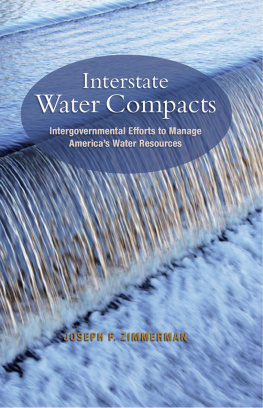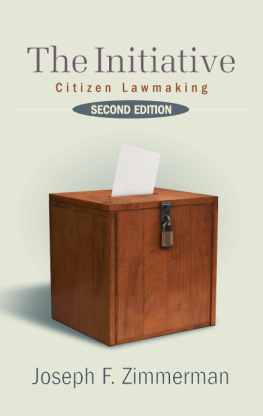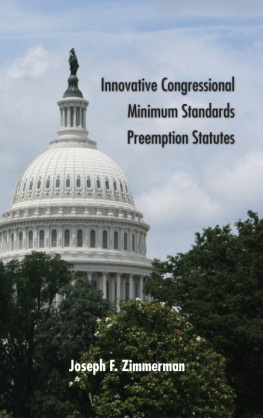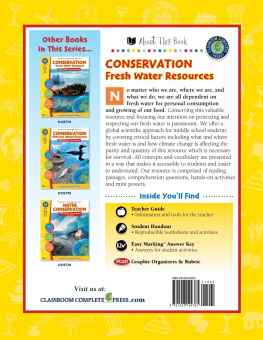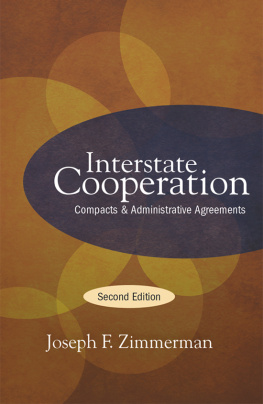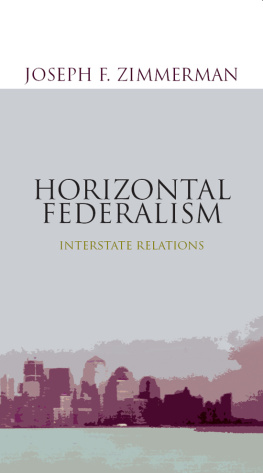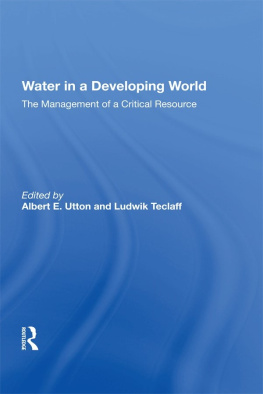2012 State University of New York
All rights reserved
Printed in the United States of America
No part of this book may be used or reproduced in any manner whatsoever without written permission. No part of this book may be stored in a retrieval system or transmitted in any form or by any means including electronic, electrostatic, magnetic tape, mechanical, photocopying, recording, or otherwise without the prior permission in writing of the publisher.
For information, contact
State University of New York Press, Albany, NY
www.sunypress.edu
Production, Laurie Searl
Marketing, Fran Keneston
Library of Congress Cataloging-in-Publication Data
Zimmerman, Joseph Francis, 1928
Interstate water compacts : intergovernmental efforts to manage America's water resources / Joseph F. Zimmerman.
p. cm.
Includes bibliographical references and index.
ISBN 978-1-4384-4447-5 (hardcover : alk. paper)
1. WaterLaw and legislationUnited States. 2. Water resources developmentLaw and legislationUnited States. 3. WaterGovernment policyUnited States. 4. Interstate agreementsUnited States. 5. Water-supplyManagement. I. Title.
KF5569.Z56 2012
333.91'17dc23
2011052139
10 9 8 7 6 5 4 3 2 1
PREFACE
The importance of fresh water is highlighted by droughts in various parts of the world and in sections of the United States with a growing population and an economy heavily dependent upon fresh water. The current and future water shortages long have been recognized, but United States Government, state, and local governments have launched only limited programs to conserve water and to increase its supply.
The United States federal system over time has become more complex as the regulatory powers of the federal government increased with continuing congressional enactment of preemption statutes, including innovative onesremoving some or all powers from state and local governments in particular regulatory fields, and congressional devolution of certain powers to states. To date, there is no national water policy coordinating the activities of the national government, state governments, and local governments.
This book examines the current use and the potential use of a device authorized by the U.S. Constitution that has proven to be very versatile and capable of solving a wide variety of public problems crossing state boundaries. The device is the interstate compact that first was authorized by Article VI of the Articles of Confederation and Perpetual Union in 1781. Only one interstate compact, between Maryland and Virginia governing the Potomac River, was entered into under the articles.
Section 10 of Article I of the U.S. Constitution similarly authorizes states to enter into interstate compacts or agreements with the consent of Congress. Enactment of an interstate compact by two or more states establishes a partnership between member states. A total of 176 compacts have received the consent of Congress. Other nonpolitical compacts are in effect and do not require the consent of Congress. The versatility of the compact device in aggregating the resources of multiple governments in an innovative manner to solve multiple problems was revealed in 1961 when the Delaware River Basin Compact was enacted into law by the state legislature in each of the basin states and by Congress, and created the first of seven federal-interstate compacts. The reader should note that there are formal and informal interstate administrative agreements and federal-interstate administrative agreements relating to a variety of subjects including water. These agreements are not enacted into law by state legislatures and hence are exempt from the consent of Congress requirement for interstate compacts.
This volume is the only one devoted to interstate compacts and federal-state compacts pertaining to abatement of water pollution, apportionment of river waters, economic development, flood control, inland fisheries, marine fisheries, and the restoration to rivers of anadromous fish, such as salmon and shad, that live in fresh water and salt water. This volume also is the first one to include a list with legal citations of all interstate compacts that received the consent of Congress, and a list with legal citations of all federal-interstate compacts. Similarly, water treaties entered into by the United States with Canada, the United Mexican States, and Native American tribes are described and legal citations are provided.
The process for entering into interstate and federal-state compacts is explained in detail as is the exercise of original jurisdiction by the U.S. Supreme Court to resolve intractable interstate controversies involving interpretation of provisions of interstate compacts, water apportionment, and water pollution abatement. An important question is raised: is the U.S. Supreme Court or Congress, the political branch, better qualified to resolve interstate water controversies?
Politics is involved in the process of negotiations leading to states entering into interstate compacts and federal-state compacts, and their activities. Furthermore, interstate politics continues as questions are occasionally raised relative to interpretation of a provision(s) of a compact and the need for a compact amendment(s). The number of water-related compacts is relatively large and the politics of some compacts has a long history and is immensely complex. It is not possible for a single volume to include a detailed analysis of the politics of each compact, but it is hoped this book will stimulate research on the subject.
The concluding chapter contains a call for the President, Congress, governors, state legislatures, and local governments to devote more attention and resources to finding solution for water-related problems. Specific recommendations to solve water-related problems are directed to federal, state, and local government officers. Congress and the President are called upon to reorganize federal departments and agencies with water-related responsibilities to reduce the fragmentation of authority hampering the development and implementation of national water policies. They also are urged to initiate action to develop a comprehensive national water plan and to keep it up to date.
Congress, the political branch of government, specifically is called upon to end its general silence on the apportionment of river waters, thereby relieving the U.S. Supreme Court of the burden of invoking its original jurisdiction to resolve interstate water controversies.
States have broad authority to enter into interstate compacts subject only to the requirement of congressional consent for political compacts. National and state government officers should employ creativity to develop innovative compacts designed to solve major problems, including the growing shortage of water. An example of such a compact is the proposed Agreement Among the States to Elect the President by National Popular Vote.



